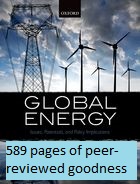It’s been a remarkable few months for wind generation in Britain, Feb 2014 – Jan 2015, and the last of those two months in particular. Several records were broken, and re-broken.
You can see the live British grid data, including wind generation, here; and here’s a version for mobiles (cellphones) and other small-screen devices.
February 2014 saw the highest monthly average metered wind power generation that Britain’s ever achieved: in that month, average generation from metered windfarms was 4.09 GW.
The half-hour starting at 06.00 on the morning of 18 October 2014 saw the highest percentage contribution of wind (penetration) to total demand: 23.5% from metered windfarms; 32.9% from all windfarms.
The half-hour starting at 19.30 on 9 December 2014 saw the highest half-hourly wind generation: 6.80 GW from metered windfarms; 9.42 GW from all windfarms.
And until January 2015, December 2014 also had the highest amount of wind-generated electricity of any month: 3.90 TWh (of which a record 2.85 TWh was from metered windfarms); and the highest monthly contribution from wind to total demand – 13.9% from all windfarms (the highest contribution from metered windfarms was 10.5%, in February 2014). But January 2015 outdid the preceeding month, with 14.4% of demand being met by metered and embedded wind; 4.13 TWh of wind in total, which was equivalent to an average power of 5.56 GW; and 2.95 TWh from the metered windfarms.
Records for electricity generation from wind in Britain
| analysis by EnergyNumbers.info | All windfarms | Metered windfarms only | |||
|---|---|---|---|---|---|
| Monthly | Max wind penetration | 14.4 % | Jan 2015 | 10.5 % | Feb 2014 |
| Maximum energy | 4.13 TWh | Jan 2015 | 2.95 TWh | Jan 2015 | |
| Max average power | 5.56 GW | Jan 2015 | 4.09 GW | Feb 2014 | |
| Half-hourly | Max wind penetration | 32.9 % | 2014-10-18 06.00-06.30 | 23.5 % | 2014-10-18 06.00-06.30 |
| Max average power | 9.42 GW | 2014-12-09 19.30-20.00 | 6.80 GW | 2014-12-09 19.30-20.00 | |
(thanks to BMReports and Elexon for the raw data I used for this analysis)

